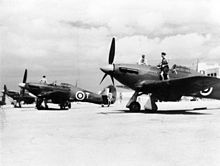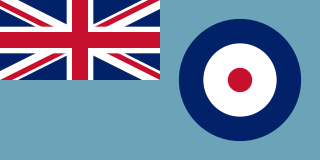
The Desert Air Force (DAF), also known chronologically as Air Headquarters Western Desert, Air Headquarters Libya, the Western Desert Air Force, and the First Tactical Air Force (1TAF), was an Allied tactical air force created from No. 204 Group RAF under RAF Middle East Command in North Africa in 1941 to provide close air support to the British Eighth Army against Axis forces. Throughout the Second World War, the DAF was made up of squadrons from the Royal Air Force (RAF), the South African Air Force (SAAF), the Royal Australian Air Force (RAAF), the United States Army Air Forces (USAAF) and other Allied air forces.

No. 1435 Flight Royal Air Force, commonly abbreviated 1435 Flt, is an independent aircraft flight of the Royal Air Force (RAF). Currently operating the Eurofighter Typhoon FGR4, it is based at RAF Mount Pleasant in the Falkland Islands. Its role is to provide air defence for the Falkland Islands, South Georgia and the South Sandwich Islands. Four aircraft are permanently based in the islands, whilst their pilots and groundcrew are cycled through No. 1435 Flight from the various Typhoon squadrons in the United Kingdom, providing a 24-hour, 365-day quick reaction alert (QRA) role.

2 Squadron is a squadron in the South African Air Force which was formed in 1940. The squadron has a long history, having been involved in every single combat action in which the SAAF has taken part. During the Second World War it made a name for itself in the battles for East Africa, before distinguishing itself in North Africa as part of the Desert Air Force, and later in Italy.

1 Squadron SAAF was an air force squadron of the South African Air Force and was formed at Air Force Station Swartkop in February 1920, equipped with De Havilland DH.9s part of the Imperial Gift donation to South Africa by Britain. On 31 August 1939 the squadron was re-designated as 1 Bomber/Fighter Squadron and this was then changed to 11 (Bomber) Squadron in December 1939. The squadron was resurrected in February 1940 by the renumbering of 6 Squadron, equipped with four Hurricane Mk 1s and six Furies.
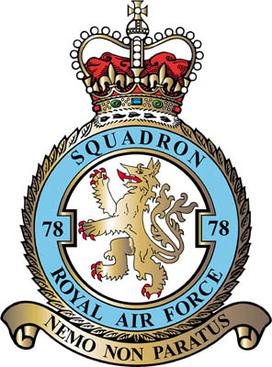
No. 78 Squadron of the Royal Air Force, is the squadron number plate of RAF (Unit) Swanwick based at London Area Control Centre, Swanwick, Hampshire. The squadron was allocated the role in early 2021.

40 Squadron SAAF existed as a combat unit from early 1940 through to late 1945. It served in the East African Campaign, Western Desert, Tunisia, and Italy, reaching Austria by the end of World War II. The squadron's motto in those years was Amethlo e Impi – "the eyes of the army".

No. 37 Squadron was a Royal Flying Corps (RFC) fighter squadron during the First World War, a Royal Air Force bomber squadron during the Second World War, and performed maritime reconnaissance in the years 1947–67.

No. 455 Squadron was a Royal Australian Air Force (RAAF) torpedo bomber squadron during World War II and became famous as part of the "ANZAC Strike Wing" that was formed from Australian and New Zealand squadrons. Raised in early 1941, mainly from Australian personnel, the squadron served over Europe during the war, operating from various bases in the United Kingdom; it also briefly sent a detachment to the Soviet Union in 1942. Operating Handley Page Hampdens and Bristol Beaufighters, the squadron mainly undertook anti-shipping and anti-submarine operations during the war. It was disbanded in May 1945 following the cessation of hostilities against Germany.
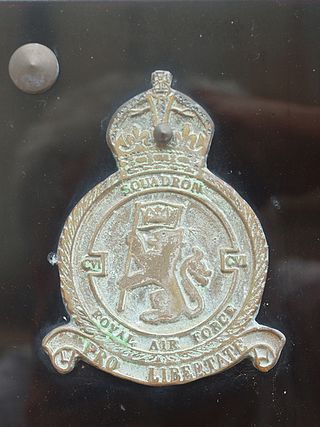
No. 106 Squadron RAF was a Royal Flying Corps and Royal Air Force squadron active from 1917 until 1919, throughout World War II and during the Cold War from 1959 until 1963.
No. 242 Squadron RAF was a Royal Air Force (RAF) squadron. It flew in many roles during the First World War, Second World War and Cold War.

Royal Air Force Thornaby, or more simply RAF Thornaby, is a former Royal Air Force Station located in the town of Thornaby-on-Tees, in the North Riding of Yorkshire, England. Fighter Command, Bomber Command and Coastal Command all operated from the base over its history, but its stint under Coastal Command is what the base was notable for, particularly in the air-sea rescue environment and the development of the Thornaby Bag. This was an emergency bag dropped to downed aircrew at sea and contained food, cigarettes and drink.
No. 243 Squadron was a flying squadron of the Royal Air Force. Originally formed in August 1918 from two flights that had been part of the Royal Naval Air Service, the squadron conducted anti-submarine patrols during the final stages of World War I. The squadron was later re-raised during World War II, operating initially as a fighter squadron in Malaya and Singapore during 1941–42. It was briefly disbanded just prior to the fall of Singapore, and was re-formed in mid-1942, again as a fighter squadron, and fought in the Tunisian and Italian campaigns in 1942–44, before being disbanded in October 1944. In 1945, after training on transport aircraft in Canada, the squadron moved to Australia where it operated in support of the British Pacific Fleet before disbanding in mid-1946.
No. 608 Squadron was an Auxiliary Air Force squadron of the Royal Air Force during the Second World War. It flew during its existence as a bomber, fighter and reconnaissance unit and was the only RAF squadron to be equipped with the unsuccessful Blackburn Botha torpedo bomber.
No. 232 Squadron of the Royal Air Force was active in both the First and Second World Wars in a variety of roles, having seen action as an anti-submarine patrol, fighter and transport squadron.
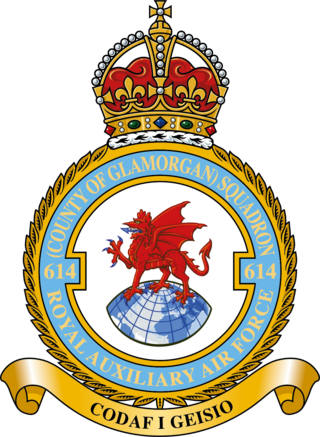
No. 614 Squadron was originally formed on 1 June 1937 as an army co-operation squadron unit of the Auxiliary Air Force. It served during the Second World War first in this role and later as a bomber squadron. Upon reformation it served as a fighter squadron until the disbandment of the Royal Auxiliary Air Force on 10 March 1957.

No. 211 Group RAF is a former Royal Air Force group which disbanded in September 1943. It initially formed in December 1941, then disbanded in February 1942. The group immediately reformed in March 1942 as No. 211 Group within RAF Middle East Command.
No. 126 Squadron RAF was a Royal Air Force Squadron formed to be a day bomber unit in World War I and reformed as a fighter unit in World War II.
No. 131 Squadron RAF was a Royal Air Force Squadron formed to be a bomber unit in World War I and reformed as a fighter unit in World War II.

11 Squadron was a World War II squadron of the South African Air Force. It was created in South Africa in 1939 and served in East Africa until 1941 as an army cooperation and reconnaissance squadron. It was re-formed in 1944 as a fighter bomber squadron and served in Italy until 1945 when it returned to Egypt and was disbanded on conclusion of the war on 30 October 1945. It was re-activated in 1974, flying Cessna 185s as an army liaison squadron until 1991 when it disbanded for the final time.

885 Naval Air Squadron was a Naval Air Squadron of the Royal Navy's Fleet Air Arm. First formed on 1 March 1941, the squadron served as a fighter squadron during the Second World War. It operated in the Mediterranean in 1942–43, where it took part in Operation Torch, the Anglo-American invasion of French North Africa, the Allied invasion of Sicily and the Allied invasion of Italy. In 1944 it took part in the Allied invasion of Normandy, spotting for Allied artillery bombardments and in 1945, was deployed as part of the British Pacific Fleet. It was abolished for the last time on 27 September 1945.
